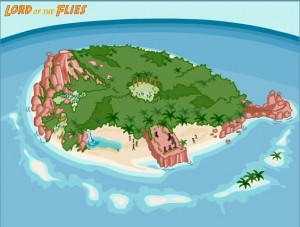“Learning is at its best when it is deadly serious and very playful at the same time.”
– Sara Lawrence Lightfoot (as cited in De Castell & Jenson, 2003, p. 649)
Overview
With the advancement of technology today views on instruction methods and learning has changed dramatically compared to a decade ago. Growing along with the gaming industry, there are advocates who see that games can play a role in formal education especially serious games/educational games. Educational games are defined to be games that have the teaching aspect built-in to the design of the game’s structure; it expands concepts, strengthens comprehension and development, and assists in learning while gaming (Educational games, 2012). Educational games present the content in an aesthetically pleasing way which encourages interactivity over detailed descriptions being read off the screen; most of the content within the game is narrated (De Castell & Jenson, 2003). Educational games focus on promoting an immersive environment over the completion of stand-alone objectives and tasks (De Castell & Jenson, 2003). Compared to the traditional instruction method, educational games offers a different learning atmosphere, as stated by De Castell & Jenson (2003) “ …gaming provides for its players a very different politics of engagement that shifts the experience of locus of control from teacher or educational program (‘feedback’) to the player (‘consequences’)” (p. 655).
Advantages
Games have the potential to be strong influential learning tools in stimulating higher order thinking, accurately reproducing phenomena, and speeding up or slowing down time instructional experiences (Charsky & Ressler, 2011). Furthermore, games can increase the learners’ problem-solving skills, knowledge, attitudes and behaviours (Liu, Cheng, Huang, 2011). Additionally, through the presentation of personified problem situations presented in the simulated computer games, the learners’ problem-solving ability is further fostered (Liu, Cheng & Huang, 2011). Games can foster students’ critical or analytical problem- solving and thinking skills (Liu et al., 2011). Game-play is considered as a problem-solving process; therefore, it is likely to endorse the flow experience (Liu et al., 2011). The “flow” experience was defined to be the consciousness condition of an individual in having control over his course of actions. The state brings together self and environment, stimulus and response, and closes the gap in time between past, present and future; therefore, learners who comprehended the flow state achieve deep learning of problem-solving (Liu et al., 2011). According to Kiili (as cited in Liu et al., 2011), games make it possible for learners to set personal goals, carrying out the task of handling and gathering information, monitoring and evaluating problem-solving processes. Self-learning abilities and inquiry strategies can be further developed as games can assist learners in understanding complex systems by applying what they have been taught (Liu et al., 2011).
Moreover, games can increase problem-solving skills because through game-play, learners will need to deal with the problems being presented to them in order to achieve their goals (Vos, Van Der Meijeden, Denessen, 2011). Furthermore, McFarlane, Sparrowhawk and Heald contends that (as cited in Vos et al., 2011) learners will also be able to increase their thinking and problem-solving skills as they will learn from their mistakes through trial-and-error as they try to resolve the problems .
Gee (as cited in Vos et al., 2011) contended that learners learn through the formulation of a hypotheses and then test them, hence games would fit into the case where learners can develop inquiry skills. Likewise, learners’ deep learning level can be improved through the use of games as it appeals to problem-solving, decision making, knowledge transfer, critical thinking and meta-analytic skills (Vos et al., 2011). Lee and Chen (as cited in Liu et al., 2011) found that students’ reasoning performances can be enhanced through the clear feedback provided through the game. Lee and Chen (as cited in Liu et al., 2011) stated that gaming allows students to have a better opportunity in constructing their own personal learning experiences which would require them to have a deeper understanding of the material and deeper problem-solving skills.
In addition, the application of logic, visualizations, memory and problem-solving in authentic situations within a game can promote and improve learning (Liu et al., 2011). Furthermore, the learning experience of the learners can be significantly impacted by games. As such, computer games have the capability in offering a pathway to change a learning experience to a positive one; hence learners will be more likely to be engaged in solving problems through meaningful strategies (Liu et al., 2011).
Besides, educational games that provide constructive, clear and concise feedback can increase engagement and increase the self-esteem of the players. The feeling of competence and self-determination of an individual increases the intrinsic motivation level of the players as well (Deci, 1976).
Drawbacks
Although educational games promote better problem-solving skills and stimulate learners’ interest and motivate them to be engaged in learning. educational games do have their drawbacks for example, educational games are based on interactivity rather than displaying detailed description of the involved content (De Castell & Jenson, 2003), and hence learners may get distracted by the aesthetics of the game and may get off track in their learning. Moreover, if the educational game was not designed well, for example instead of giving the player the opportunity of having immersive navigation with unlimited interaction (De Castell & Jenson, 2003 ) the game might be designed poorly that limits the learning experience because it was a game designed to have interaction aspects between the game and the player only but not allowing the player to make decisions for their next move. Furthermore, repetition of navigating throughout the game can lead to boredom and players can lose their interest in the material. Lastly, like many games, educational games include the fantasy aspect and players can create imaginary fantasy characters which may have a lot of power, success, and things that are not present in the real life for these players. However, with their emotional needs being satisfied through a game, these players may not be able to accept back their real life once they are not playing the game anymore as they have lost their cyberspace characteristics.
Examples of Educational Games
Quest Atlantis (QA) has 3D multi-user computer graphics that uses narrative programming to incorporate useful tasks that attracts the attention of children from ages 9 to 15. In addition, it uses a combination strategy of both educational research lessons and commercial gaming environment to further enhance the game’s learning and motivation. Its combination of learning, playing and helping works together with one another to engage and motivate the students who use it. The ability to finish quests and to engage with other users and mentors throughout the game builds a virtual experience for the user which further engages the user making it a more attractive game. The main goal or intention of this game is mainly to attract the students into learning more about disciplinary knowledge and to introduce them in educational worlds of role modeling professional practices in a path to accomplish desired goals.
Based on the book Lord of the Flies this educational game is used to challenge learners’ memory through gameplay. This educational game’s intention is to present the fundamental analytical aspects of the book.
Math Blaster is an online educational game for children to practice their math skills while playing the game. Math Blaster is steered towards elementary level math. The game utilizes fantasy characters and futuristic online adventures to attract its users. Math Blaster is multilingual, hence it is available in various languages. Math Blaster also has a mobile app version that can be downloaded from the app store.
References
Charsky, D., & Ressler, W. (2011). “Games are made for fun”: Lessons on the effects of concept maps in the classroom use of computer games. Computers & Education, 56, 604-615.
De Castell, S., & Jenson, J. (2003). Serious play. J. Curriculum Studies, 35(6), 649-665.
Deci, E. L., (1976). The hidden costs of rewards. Organizational Dynamics, Winter 76, 4 (3), 61-72.
Educational games. (2012, May 29). Retrieved from http://en.wikipedia.org/wiki/Educational_game.
Foster, T. (2008, October 21). Quest atlantis – getting started [Video file]. Retrieved from https://www.youtube.com/watch?v=VH5Vh96Lftw.
Liu, C. C., Cheng, Y. B., & Huang, C. W. (2011). The effect of simulation games on the learning of computational problem solving. Computers & Education, 57, 1907-1918.
Lord of the flies. (2012). Retrieved from http://www.nobelprize.org/educationa/literature/golding/about.html
Math blaster. (2012, June 6). Retrieved from http://www.mathblaster.com/Default.aspx
Parish, J. (2010). The most important games ever made . Retrieved from http://www.1up.com/features/the-essential-50.
Quest Atlantis. (2012, May 9). Retrieved from http://en.wikipedia.org/wiki/Quest_Atlantis.
Vos, N., Van Der Meijden, H., & Denessen, E. (2011). Effects of constructing versus playing an educational game on student motivation and deep learning strategy use. Computers & Education, 56, 127-137.
Authored by Karon Wong


